Abstract
The cytotoxicity of amodiaquine (AQ), amodiaquine quinoneimine (AQQI) and desethylamodiaquine (AQm) has been assessed in comparison with that of chloroquine (CQ) using mononuclear leucocytes (MNL) and granulocyte/monocyte colony forming units (GM-CFU) from haematologically normal subjects. Toxicity toward MNL was assessed after 2 h and 16 h incubations with each compound. After 2 h, AQ, AQm and AQQI but not CQ (within the concentration range 1-100 mumols l-1) produced a significant decrease in cell viability. After 16 h, all four compounds significantly increased cell death. After both 2 h and 16 h incubations CQ was the least toxic and AQQI the most toxic of the four compounds towards MNL. Toxicity to GM-CFU was assessed by the inhibition of colony formation in vitro. After 10-14 days incubation, there was significant concentration-dependent inhibition of colony formation by AQ, AQm, AQQI and CQ (within the range 0.1-10.0 mumols l-1). There were no significant differences between the ability of the four compounds to inhibit colony formation but toxicity towards GM-CFU was observed at drug concentrations at least 10-fold lower than those that were toxic to MNL. These data show that the four compounds are equally toxic in vitro toward GM-CFU, although some differences in their toxicity toward MNL were seen. The possible mechanisms of AQ's toxicity are discussed.
Full text
PDF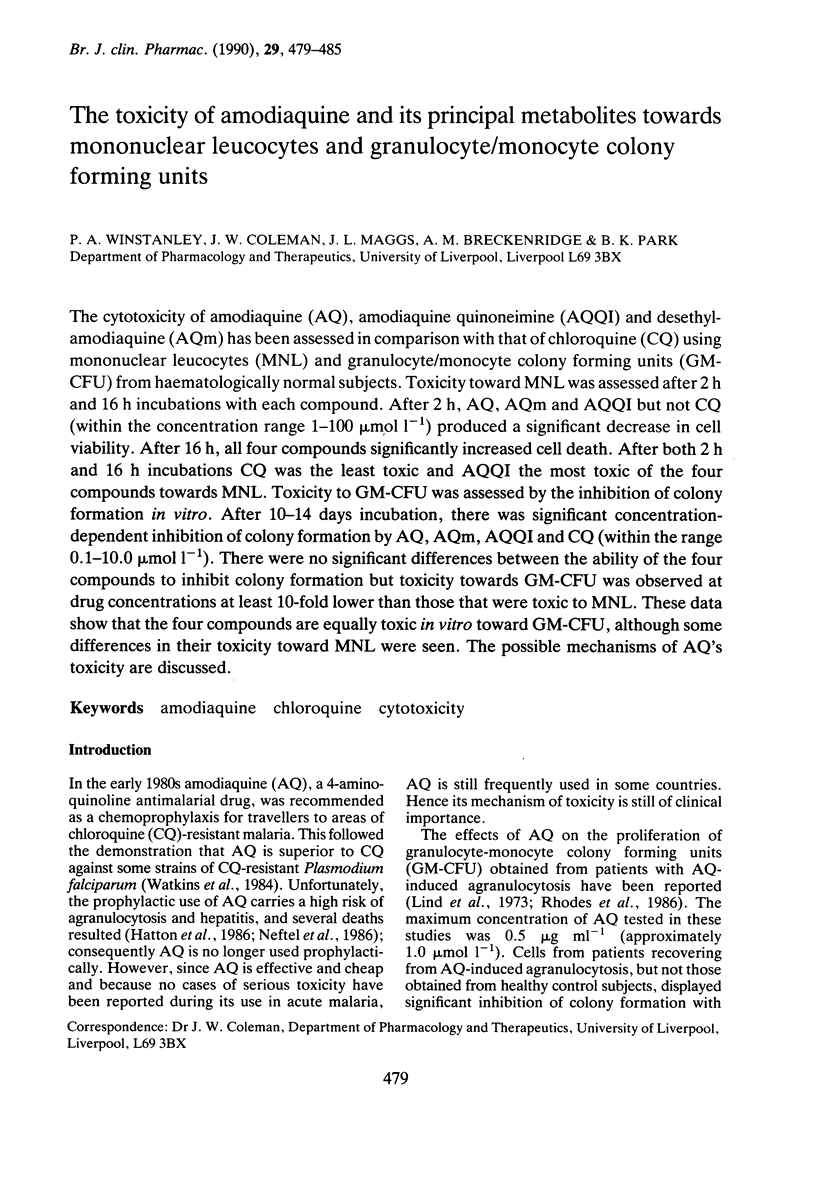
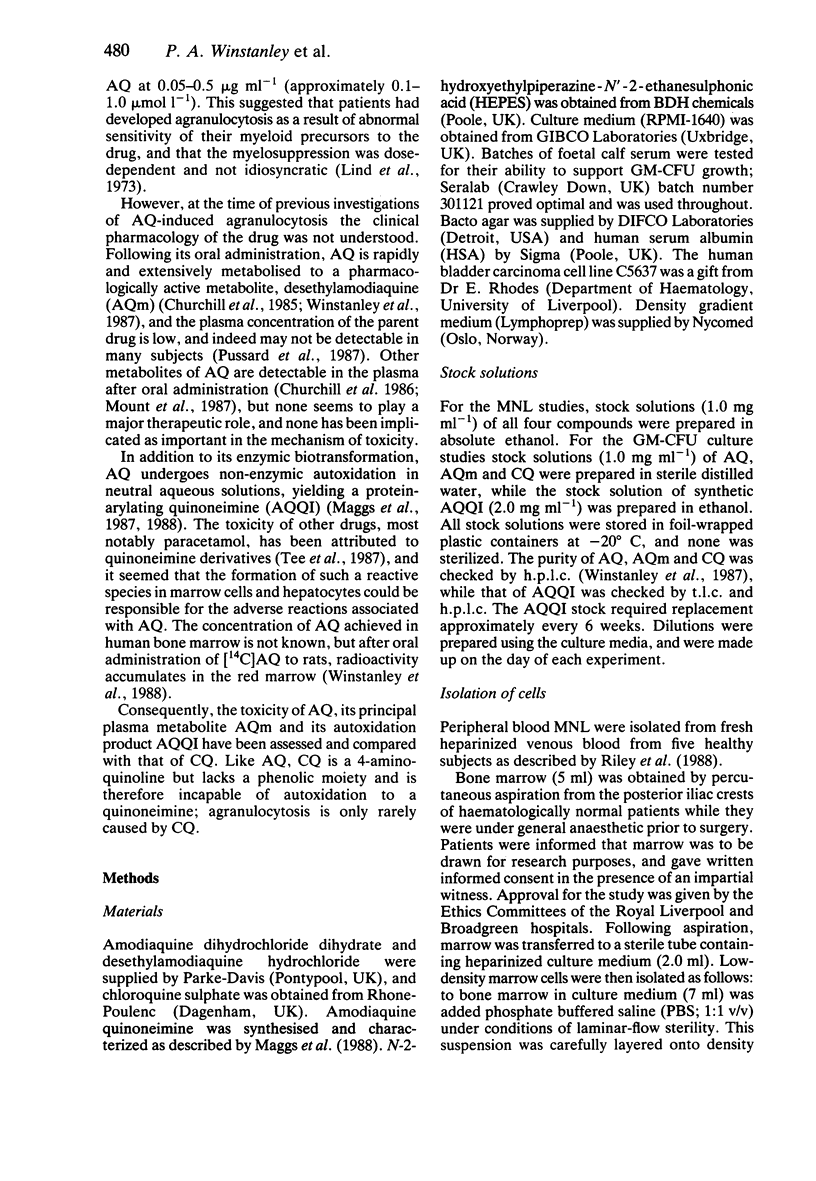
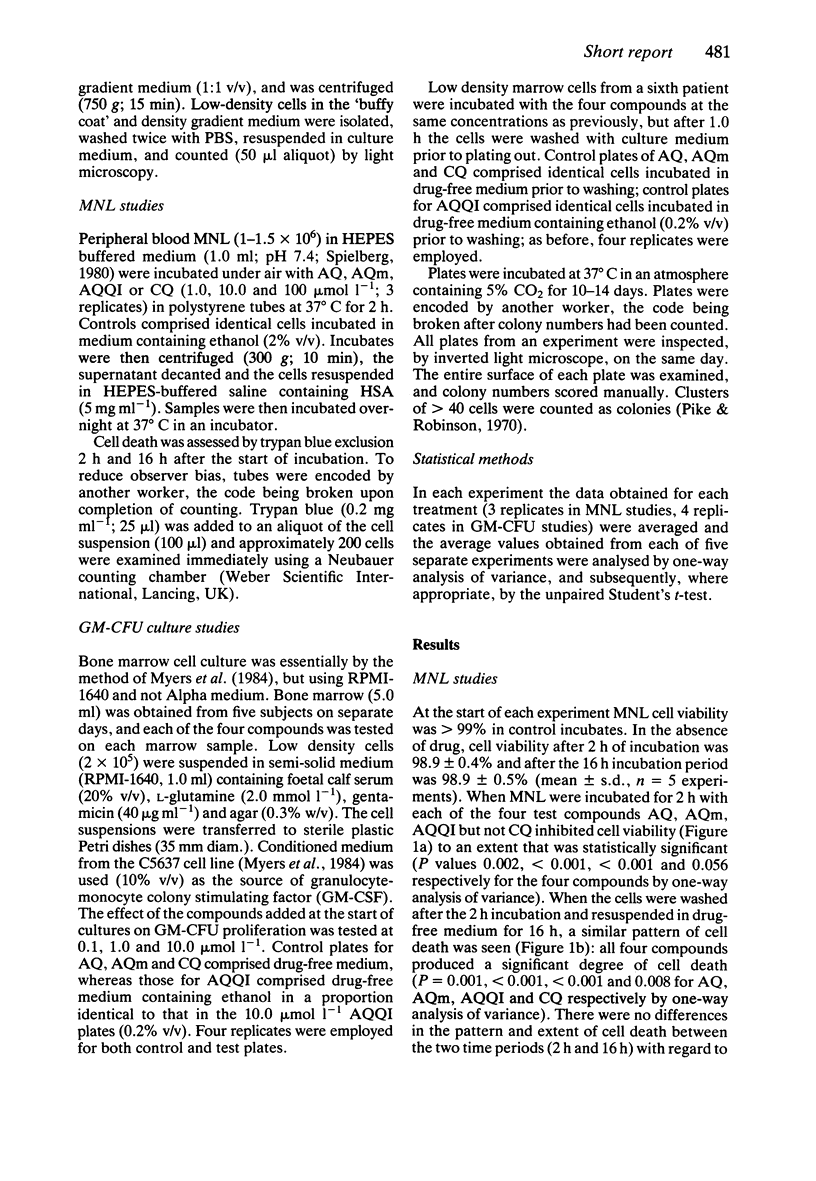
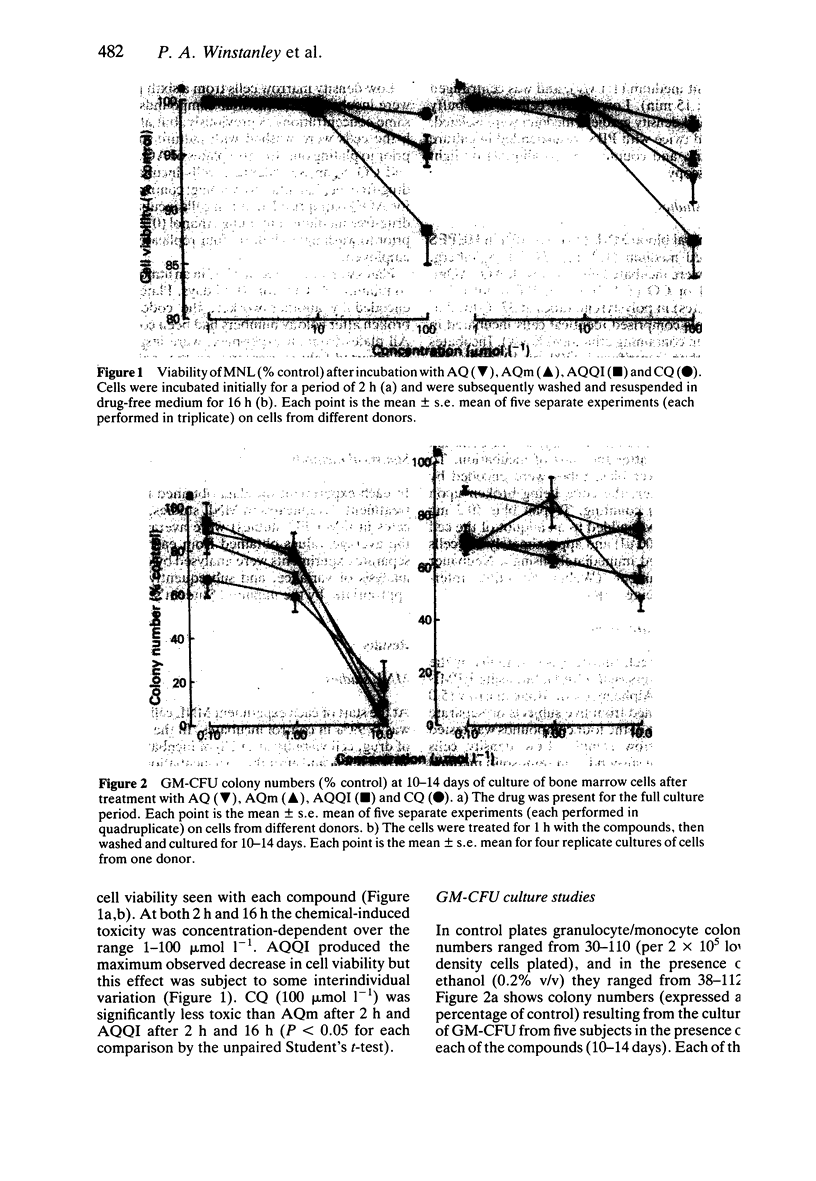
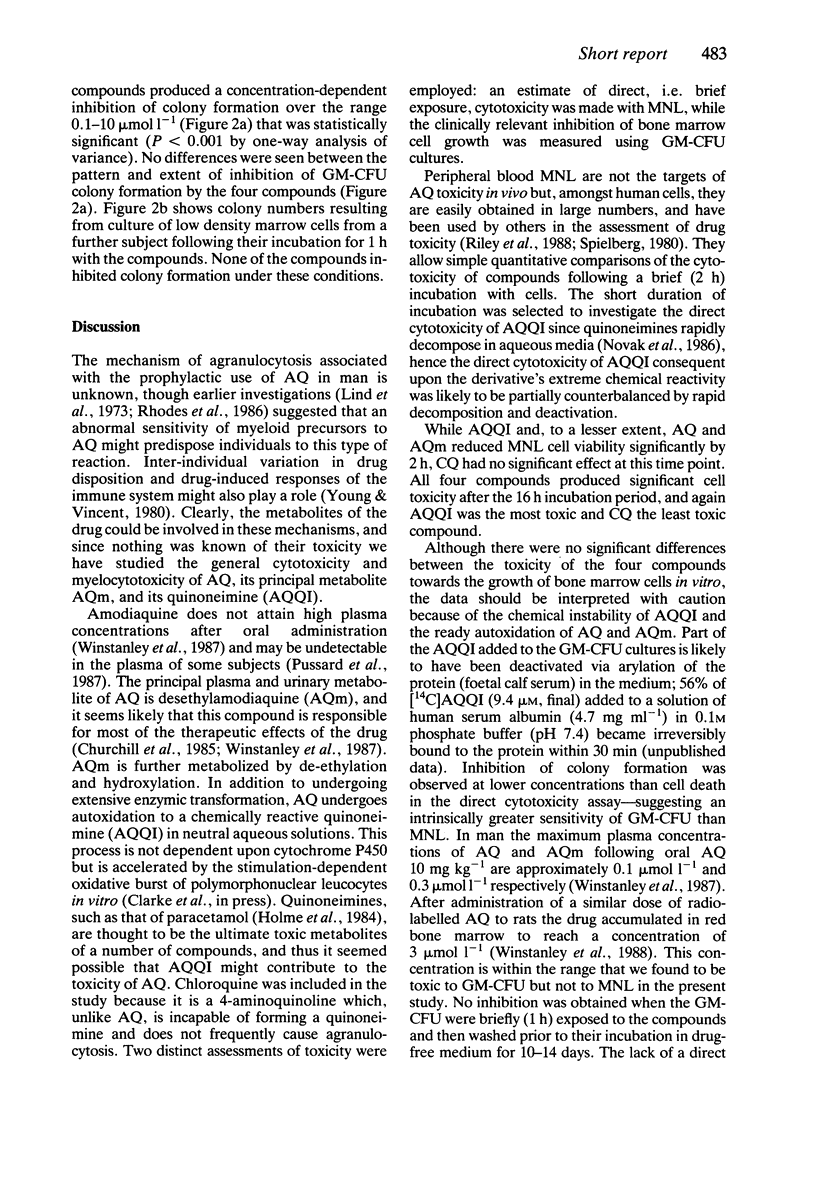
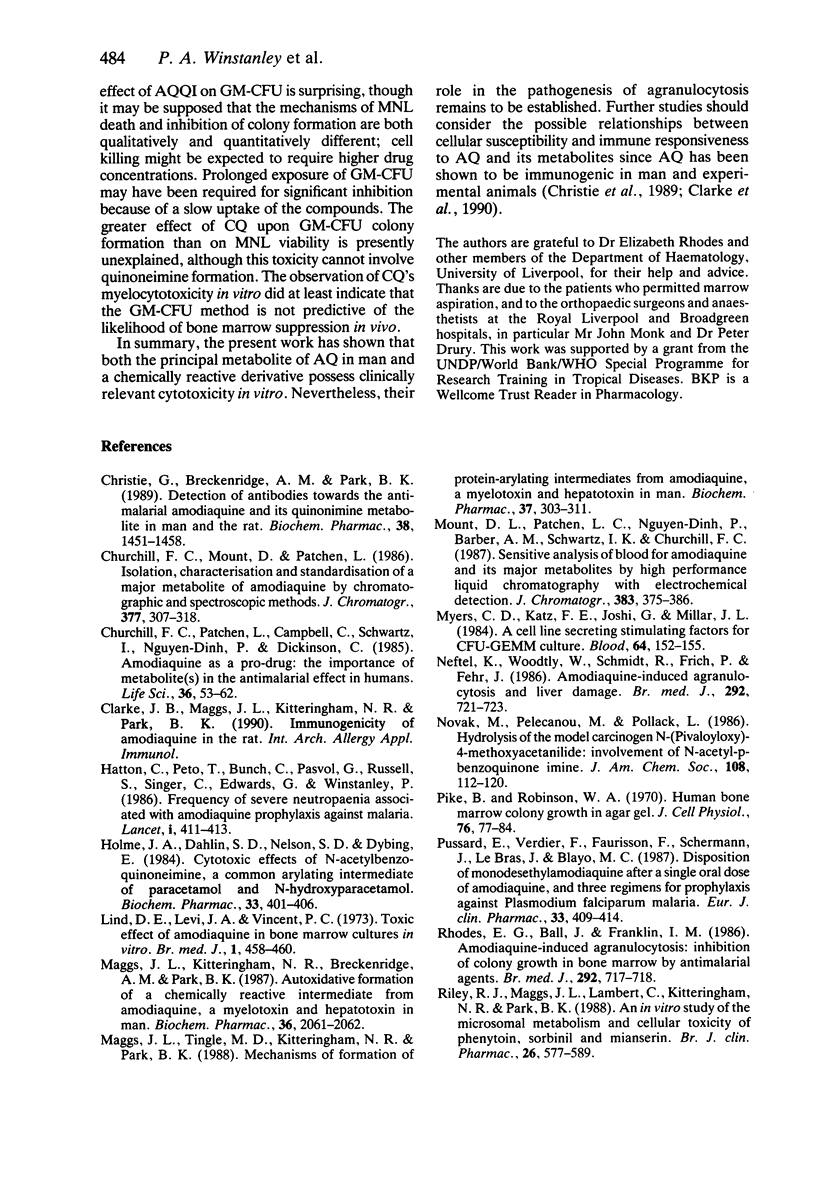
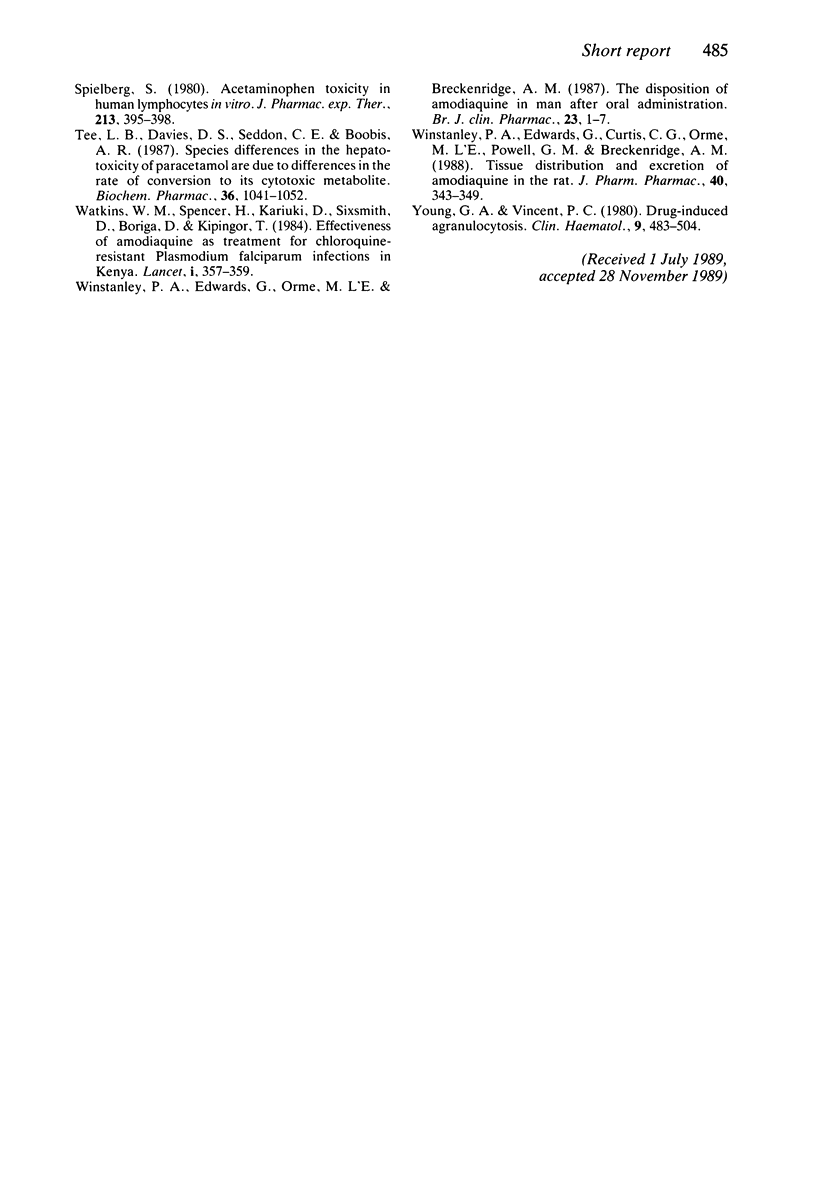
Selected References
These references are in PubMed. This may not be the complete list of references from this article.
- Christie G., Breckenridge A. M., Park B. K. Drug-protein conjugates--XVIII. Detection of antibodies towards the antimalarial amodiaquine and its quinone imine metabolite in man and the rat. Biochem Pharmacol. 1989 May 1;38(9):1451–1458. doi: 10.1016/0006-2952(89)90184-6. [DOI] [PubMed] [Google Scholar]
- Churchill F. C., Mount D. L., Patchen L. C., Björkman A. Isolation, characterization and standardization of a major metabolite of amodiaquine by chromatographic and spectroscopic methods. J Chromatogr. 1986 Apr 25;377:307–318. doi: 10.1016/s0378-4347(00)80786-0. [DOI] [PubMed] [Google Scholar]
- Churchill F. C., Patchen L. C., Campbell C. C., Schwartz I. K., Nguyen-Dinh P., Dickinson C. M. Amodiaquine as a prodrug: importance of metabolite(s) in the antimalarial effect of amodiaquine in humans. Life Sci. 1985 Jan 7;36(1):53–62. doi: 10.1016/0024-3205(85)90285-1. [DOI] [PubMed] [Google Scholar]
- Hatton C. S., Peto T. E., Bunch C., Pasvol G., Russell S. J., Singer C. R., Edwards G., Winstanley P. Frequency of severe neutropenia associated with amodiaquine prophylaxis against malaria. Lancet. 1986 Feb 22;1(8478):411–414. doi: 10.1016/s0140-6736(86)92371-8. [DOI] [PubMed] [Google Scholar]
- Holme J. A., Dahlin D. C., Nelson S. D., Dybing E. Cytotoxic effects of N-acetyl-p-benzoquinone imine, a common arylating intermediate of paracetamol and N-hydroxyparacetamol. Biochem Pharmacol. 1984 Feb 1;33(3):401–406. doi: 10.1016/0006-2952(84)90232-6. [DOI] [PubMed] [Google Scholar]
- Lind D. E., Levi J. A., Vincent P. C. Amodiaquine-induced agranulocytosis: toxic effect of amodiaquine in bone marrow cultures in vitro. Br Med J. 1973 Feb 24;1(5851):458–460. doi: 10.1136/bmj.1.5851.458. [DOI] [PMC free article] [PubMed] [Google Scholar]
- Maggs J. L., Kitteringham N. R., Breckenridge A. M., Park B. K. Autoxidative formation of a chemically reactive intermediate from amodiaquine, a myelotoxin and hepatotoxin in man. Biochem Pharmacol. 1987 Jul 1;36(13):2061–2062. doi: 10.1016/0006-2952(87)90130-4. [DOI] [PubMed] [Google Scholar]
- Maggs J. L., Tingle M. D., Kitteringham N. R., Park B. K. Drug-protein conjugates--XIV. Mechanisms of formation of protein-arylating intermediates from amodiaquine, a myelotoxin and hepatotoxin in man. Biochem Pharmacol. 1988 Jan 15;37(2):303–311. doi: 10.1016/0006-2952(88)90733-2. [DOI] [PubMed] [Google Scholar]
- Mount D. L., Patchen L. C., Nguyen-Dinh P., Barber A. M., Schwartz I. K., Churchill F. C. Sensitive analysis of blood for amodiaquine and three metabolites by high-performance liquid chromatography with electrochemical detection. J Chromatogr. 1986 Dec 19;383(2):375–386. doi: 10.1016/s0378-4347(00)83483-0. [DOI] [PubMed] [Google Scholar]
- Myers C. D., Katz F. E., Joshi G., Millar J. L. A cell line secreting stimulating factors for CFU-GEMM culture. Blood. 1984 Jul;64(1):152–155. [PubMed] [Google Scholar]
- Neftel K. A., Woodtly W., Schmid M., Frick P. G., Fehr J. Amodiaquine induced agranulocytosis and liver damage. Br Med J (Clin Res Ed) 1986 Mar 15;292(6522):721–723. doi: 10.1136/bmj.292.6522.721. [DOI] [PMC free article] [PubMed] [Google Scholar]
- Pike B. L., Robinson W. A. Human bone marrow colony growth in agar-gel. J Cell Physiol. 1970 Aug;76(1):77–84. doi: 10.1002/jcp.1040760111. [DOI] [PubMed] [Google Scholar]
- Pussard E., Verdier F., Faurisson F., Scherrmann J. M., Le Bras J., Blayo M. C. Disposition of monodesethylamodiaquine after a single oral dose of amodiaquine and three regimens for prophylaxis against Plasmodium falciparum malaria. Eur J Clin Pharmacol. 1987;33(4):409–414. doi: 10.1007/BF00637639. [DOI] [PubMed] [Google Scholar]
- Rhodes E. G., Ball J., Franklin I. M. Amodiaquine induced agranulocytosis: inhibition of colony growth in bone marrow by antimalarial agents. Br Med J (Clin Res Ed) 1986 Mar 15;292(6522):717–718. doi: 10.1136/bmj.292.6522.717. [DOI] [PMC free article] [PubMed] [Google Scholar]
- Riley R. J., Maggs J. L., Lambert C., Kitteringham N. R., Park B. K. An in vitro study of the microsomal metabolism and cellular toxicity of phenytoin, sorbinil and mianserin. Br J Clin Pharmacol. 1988 Nov;26(5):577–588. doi: 10.1111/j.1365-2125.1988.tb05298.x. [DOI] [PMC free article] [PubMed] [Google Scholar]
- Spielberg S. P. Acetaminophen toxicity in human lymphocytes in vitro. J Pharmacol Exp Ther. 1980 May;213(2):395–398. [PubMed] [Google Scholar]
- Tee L. B., Davies D. S., Seddon C. E., Boobis A. R. Species differences in the hepatotoxicity of paracetamol are due to differences in the rate of conversion to its cytotoxic metabolite. Biochem Pharmacol. 1987 Apr 1;36(7):1041–1052. doi: 10.1016/0006-2952(87)90412-6. [DOI] [PubMed] [Google Scholar]
- Watkins W. M., Sixsmith D. G., Spencer H. C., Boriga D. A., Kariuki D. M., Kipingor T., Koech D. K. Effectiveness of amodiaquine as treatment for chloroquine-resistant Plasmodium falciparum infections in Kenya. Lancet. 1984 Feb 18;1(8373):357–359. doi: 10.1016/s0140-6736(84)90410-0. [DOI] [PubMed] [Google Scholar]
- Winstanley P. A., Edwards G., Curtis C. G., Orme M. L., Powell G. M., Breckenridge A. M. Tissue distribution and excretion of amodiaquine in the rat. J Pharm Pharmacol. 1988 May;40(5):343–349. doi: 10.1111/j.2042-7158.1988.tb05264.x. [DOI] [PubMed] [Google Scholar]
- Winstanley P., Edwards G., Orme M., Breckenridge A. The disposition of amodiaquine in man after oral administration. Br J Clin Pharmacol. 1987 Jan;23(1):1–7. doi: 10.1111/j.1365-2125.1987.tb03002.x. [DOI] [PMC free article] [PubMed] [Google Scholar]
- Young G. A., Vincent P. C. Drug-induced agranulocytosis. Clin Haematol. 1980 Oct;9(3):483–504. [PubMed] [Google Scholar]


